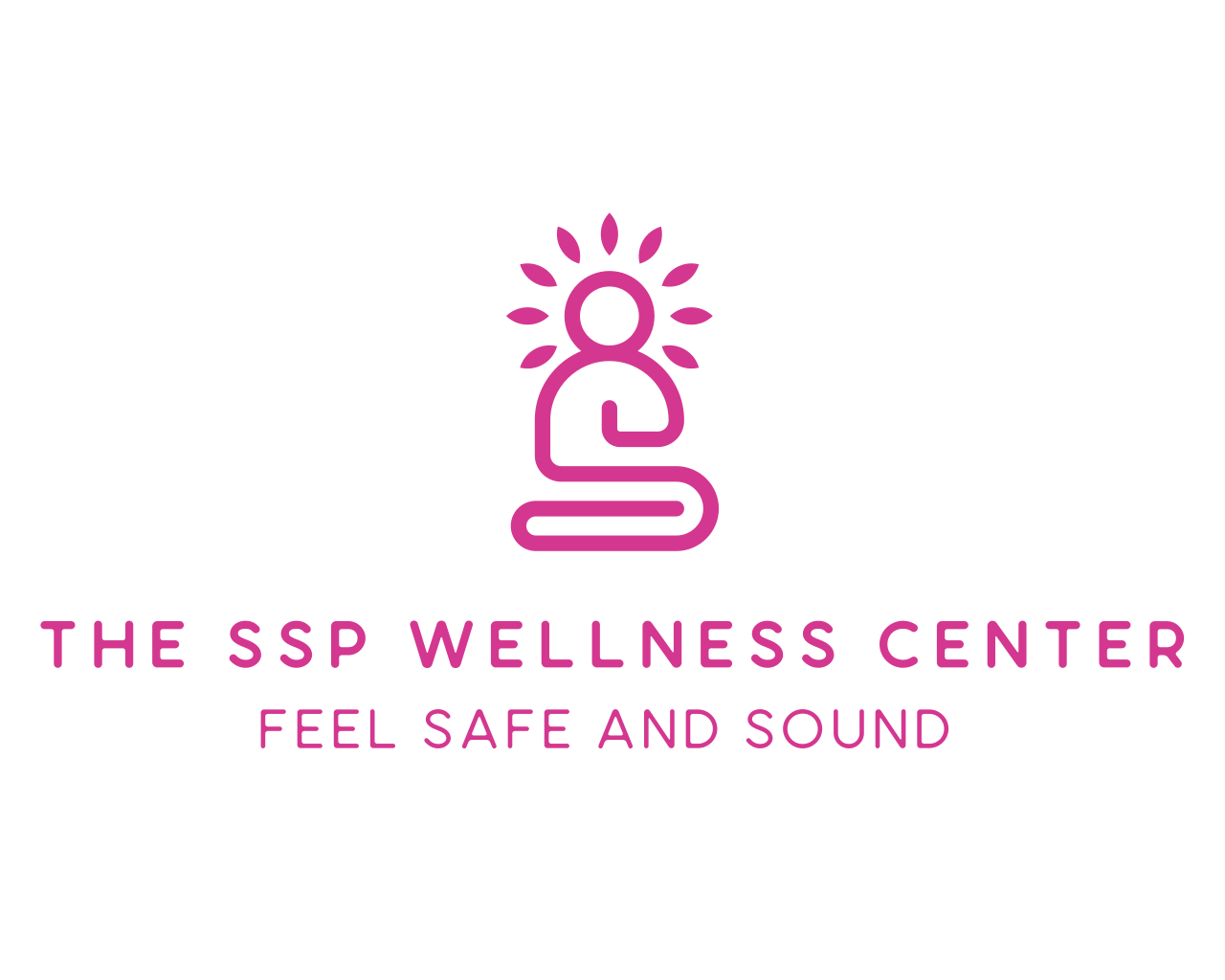Got burning questions about the SSP? You’re in the right place.
We’ve gathered up some of the questions we hear most often from curious clients and current users.
This guide will answer everything from “Can SSP really help my anxiety?” to “Can my dog do SSP?” and “Are there any Classic Rock tunes on the SSP playists?”
Let’s find out.
Using SSP for Specific Conditions
Can I Use SSP for Trauma Recovery?
Yes, SSP is frequently used to support trauma recovery. Because trauma can create lasting imprints on the nervous system—keeping it stuck in a fight-or-flight or shutdown mode—SSP can help “unstick” these patterns. By gently resetting the nervous system, SSP can ease physiological responses often linked with trauma, like hypervigilance, anxiety, and emotional reactivity. But because trauma recovery is complex, we encourage you to go slow to ensure your experience is safe and effective, with minimal side effects.[*][*]
What About SSP for ADHD?
SSP can be a powerful complementary tool for managing ADHD. Because ADHD involves more than just attention challenges, SSP targets the underlying nervous system dysregulation that often accompanies ADHD. The protocol’s calming effect on the nervous system can help reduce hyperactivity, improve focus, and support emotional regulation, making it easier to manage day-to-day life. SSP can support ADHD as a standalone therapy, but also serves as a tool to create the groundwork needed for other ADHD supports and treatments to really take root.[*]
Can I Use SSP for Misophonia?
SSP may benefit people with misophonia, a condition where certain sounds (like chewing or tapping) trigger intense emotional and physical reactions. By gently resetting the nervous system and improving auditory processing, SSP may reduce the intensity of these reactions. BUT, specific measures need to be in place. For more info, read up on how we handle contraindications here.
What About SSP for Anxiety?
SSP is ideal for managing anxiety because it directly targets the fight-or-flight response, which often underlies anxious feelings. As SSP works to calm the nervous system, it helps you feel more at ease, less reactive, and better equipped to handle life’s curveballs. Over time, you might notice that anxious patterns gradually start to fade, and moments of calm become easier to hold onto.[*][*]
Can I Use SSP for Depression?
Yes, SSP can support individuals with depression by regulating the nervous system, reducing feelings of overwhelm, exhaustion and isolation. SSP also helps create a solid foundation for other mental health practices, making it easier to engage in life and respond to therapeutic efforts. It’s a great tool in a holistic approach to depression, and we can connect you with other wellness practitioners if you need further support.[*]
Can I Do SSP on My Pets?
Yes! SSP has been beneficial for pets experiencing anxiety or stress-related behaviors. We’ve even used it on our cat, Dooney! If you’re curious about doing SSP with your pet, let us know, and we’ll devise a bespoke program for you.
Questions About Progress and Results
What Happens if I Stop the Program Halfway Through?
Stopping is always an option! We actually encourage regular pauses for people with sensitive systems and contraindicated conditions. Pausing lets your nervous system integrate each step before moving on to the next one.
But SSP is a five-hour program designed to build progress, so stopping early may mean you won’t experience its full benefits.
If you feel uncomfortable at any point, reach out to us. We’re all about adjusting to make sure your experience is manageable and comfortable.
What Happens After the Program Ends?
The benefits of SSP build up over time, so don’t worry if there’s no big “aha” moment in your final second of listening. Results continue to build over the program’s course and can keep expanding for up to 12 weeks post-program.
Often, these shifts show up as small but steady changes—like sleeping better, feeling more social, or handling stress with greater ease. So, finishing SSP isn’t the end—it’s more like planting seeds that keep growing.
When Will I See Results?
This varies. Some people notice small shifts right away, like feeling lighter or more relaxed, while others need a few weeks to really notice changes. Watch for subtle signs like improved mood, easier sleep, or smoother social interactions—progress can be a gradual build – but even tiny shifts are signals that your system is responding.
Not so good at noticing subtle changes? Don’t worry, we guide you on what to look out for.
Am I Regressing?
If it feels like old symptoms or behaviors are coming up, don’t worry. This isn’t necessarily regression but rather your nervous system processing and reorganizing. If it feels uncomfortable, reach out, and we can help you slow down to ease this integration phase.
Am I Really Getting Any Benefit From Sessions That Only Last a Few Seconds?
Yes, absolutely! In SSP, microdosing—short sessions of even just a few seconds—can deliver BIG benefits. Your nervous system often needs only a small amount of activation to respond and start shifting. Think of it as giving your nervous system a tiny, manageable “stretch” rather than a full workout. Over time, these seconds build into big changes without overwhelming the system. You can read more about why, here.

Using and Adjusting the SSP App
Why Does My Music Volume Change After the Listening Test?
Totally normal! The SSP music is filtered, unlike the test track, which can make it sound quieter or softer. As long as the volume feels comfortable at the start of your session, resist the urge to adjust—it’s working, even if it sounds different.
How Do I Adjust My Session Time?
Adjusting your session time is easy! Use the green drag bar to set the length you want before hitting play. If you’re aiming for less than a minute, you’ll need to keep an eye on the timer and press pause manually. Just tap “End Session” when you’re done, and your progress will be saved.
Why Does My Music Sound Different at Different Times?
SSP music does sound “different” at times, with the volume fluctuating as well as the sound quality. This is the effect of the all-important filtering on the music’s sound frequencies. It is these very frequencies that are working behind the scenes to reset your nervous system, by providing it with sounds of safety. So, don’t worry—it’s a natural part of the experience.
For a deeper dive into the science, check out this article.
Routine and Pacing with SSP
Do I Need to Listen at the Same Time Every Day?
Not necessarily, though routine can be helpful! Your nervous system may appreciate the predictability of listening at a consistent time. But if life gets in the way, don’t stress—just tune in when it feels comfortable.
How Long Is It Okay to Break For?
A break of a few days or even up to a maximum of 2 weeks is fine and won’t set you back. If you have a more sensitive system, routine pauses are actually very beneficial and help the nervous system absorb progress.
Just let us know if you’re feeling the need to pause, and keep us posted on any symptoms that might surface – as this may also be a sign that a break is needed.
How Many Rounds of SSP Might I Need?
Most people see benefits after one round of SSP, but it can vary. Some with more complex or long-standing challenges might benefit from repeating SSP after a few months. Many clients find doing SSP as needed—after stressful events or life transitions—can also work as a great nervous system “reset”.
Can I Repeat SSP?
Absolutely, you can repeat SSP! There are plenty of reasons people choose to do additional rounds. Think of trauma and dysregulation like an onion with many layers—one round of SSP might help peel back some outer layers, easing certain symptoms or triggers, while each additional round can go a bit deeper.
Many people also use SSP as a gentle “reset” after times of stress or illness. It’s common to revisit SSP periodically to strengthen the benefits, especially when it’s part of a broader healing approach with other therapies or practices.[*]
How to Co-Regulate with a Child or Adult Who Can’t Be Regulated Easily
Co-regulation can be tricky if your loved one finds it tough to stay grounded or if they find physical connection uncomfortable. We find that creating routines around SSP and rewarding those routines is a great way to reinforce predictability and safety without physical touch. We’re here if you need more tips on this!
How Much Activation is Enough in SSP?
A slight activation in symptoms is usually plenty. While it can be normal to see old symptoms surface, your experience should always be manageable. If you feel intense reactions, that’s a signal to slow down. Over time, you’ll build resilience at a pace that feels right for you. To understand more on how we manage symptoms and activation, take a look at this post.

Effects and Long-Term Impact
How Long Do the Effects Last? Do They Wear Off?
For many, the benefits of SSP are ongoing and permanent – especially when paired with consistent self-regulation practices. While there’s no hard rule, consistent routines and regular check-ins with your system can keep the effects strong. If you feel the effects waning, consider another round to bolster your results.
Is SSP Addictive?
Nope! SSP isn’t addictive. It’s designed to support the nervous system in building resilience, not dependency. Instead of relying on SSP, your system grows stronger, more regulated, and better equipped to handle stress on its own.[*]
Will It Make My Child’s Behaviors Worse?
Sometimes, new behaviors pop up as your child’s nervous system adjusts, but these tend to be temporary. If anything feels intense or concerning, let us know—we’ll help adjust the program to keep things manageable.
The SSP Music
What is the SSP Music like?
The music on SSP isn’t your typical playlist. It’s specially filtered to engage and calm your nervous system by focusing on mid-range frequencies that our brains associate with safety, like the tones of a soothing voice.
There are 5 playlists available with everything from gentle classical pieces, to Disney tunes, calming instrumental tracks, and some familiar feel-good pop and rock songs. For a full rundown, check out or post on the SSP playlists.
Equipment Needed for SSP Listening
What Devices Can I Listen On?
The Unyte ILS app, which delivers the SSP playlists, is available for both iOS and Android devices. Make sure your device meets the requirements: iOS 12 or higher and Android 5 or higher. Once subscribed, we will send you a link to download the app, and simple instructions to set up your account. Its super easy and can be done in a matter of minutes.
What Kind of Headphones Do I Need?
Headphones are essential for SSP because they directly deliver the specific sound frequencies designed to stimulate your middle ear and vagus nerve, which help reset your nervous system.
Here’s what to look for:
- Wired, Over-Ear Headphones: These provide consistent, high-quality sound without Bluetooth interruptions. Earbuds are a no-no.
- No Noise-Canceling Features: Stick with regular headphones that let in natural background sounds, which are part of the SSP experience. These are sometimes known as “passive” headphones.
- No Extra Sound Tweaks: Skip any sound adjustments or equalizers to make sure the SSP music plays as intended.
Once subscribed, we will provide you with a handy guide to buying the perfect SSP headphones -including recommendations for our favorite brands. And don’t worry – there’s an option for every budget.
What if My Device Doesn’t Have a Headphone Jack?
No headphone jack? No problem! You just need a 3.5mm adapter, available at stores like Best Buy, Amazon, or the Apple Store, to connect your wired headphones.
Can I Use Speakers?
If headphones feel overwhelming (especially for young kids, those with sensory issues, or sound sensitivities), speakers may be an option. However, this setup won’t be as precise, so we recommend consulting with us first to determine a program suitable for your needs.
We hope you find some answers in these FAQ’s – but if we haven’t covered your concerns, drop us an email or schedule a free 20 minute call. We’d be happy to help!

